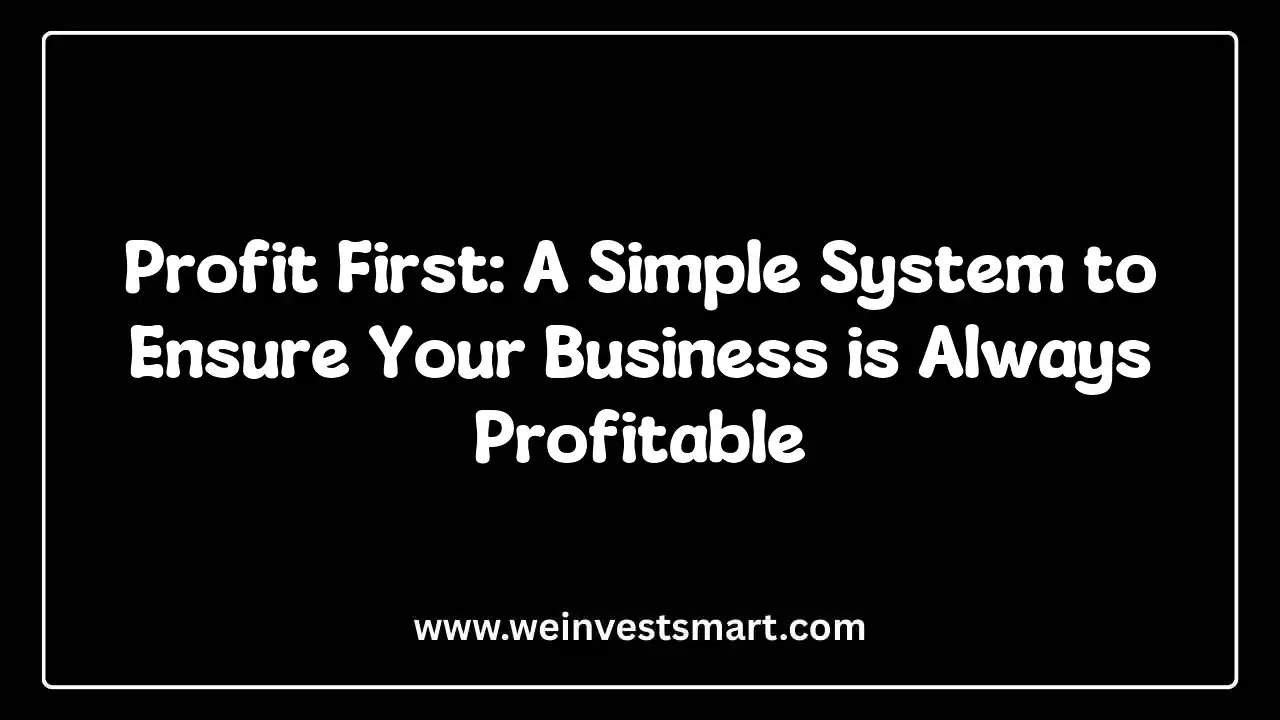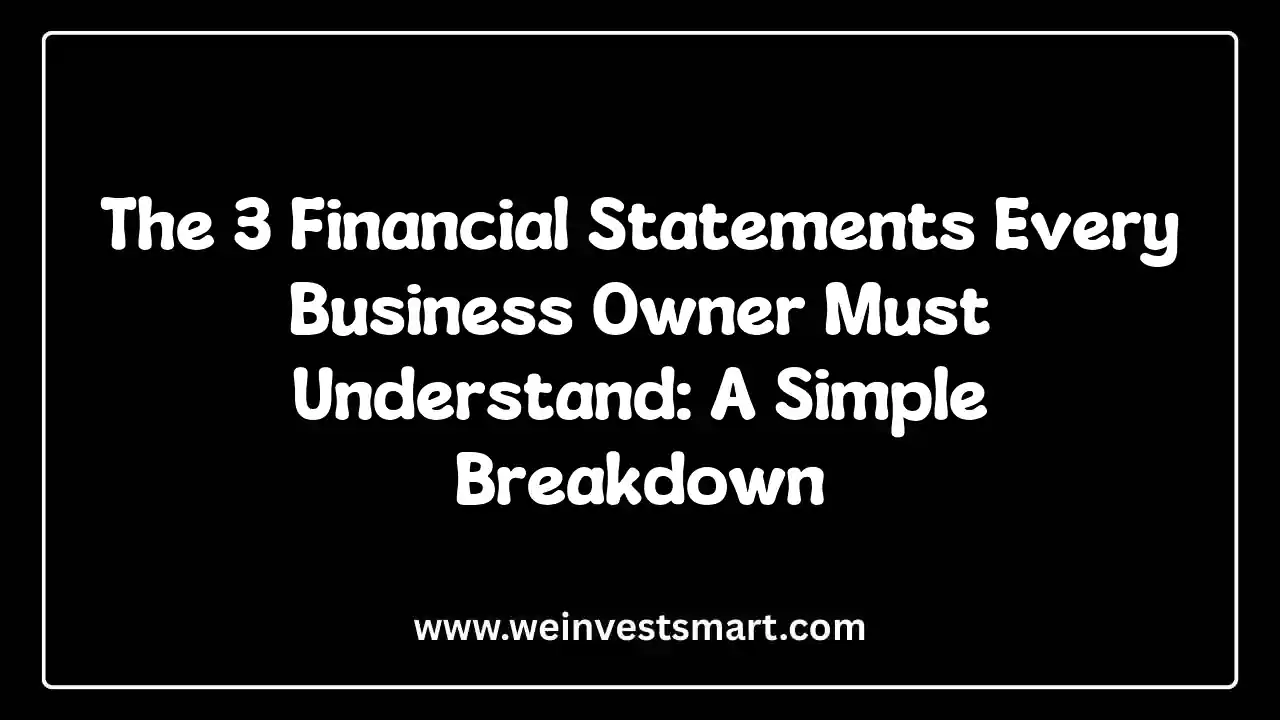· WeInvestSmart Team · business-finance · 10 min read
Managing Business Cash Flow: 7 Tips to Avoid the "Cash Crunch"
Practical advice for maintaining healthy cash flow. Learn how to invoice promptly, keep operating expenses lean, build a cash reserve, and secure a business line of credit before you need it.
Most business owners are obsessed with the wrong metric, and it’s killing their companies. They chase sales, celebrate profits, and post impressive revenue numbers, all while their business is silently suffocating. Here’s the uncomfortable truth: profit is an opinion, but cash is a fact. Studies have shown that a staggering 82% of business failures are due to poor cash flow management. That is to say, even wildly profitable companies can go bankrupt, not because they weren’t successful, but because they ran out of actual money to pay their bills.
We’ve been conditioned by the simple formula: Sales - Expenses = Profit. But what most people don’t know is that this equation tells you nothing about the oxygen your business needs to survive day-to-day. That oxygen is cash flow—the real, tangible money moving in and out of your bank account.
Here’s where things get interesting. Managing cash flow isn’t some dark art reserved for CFOs; it’s a set of simple, learnable disciplines. It’s about managing the timing of your lifeblood. And this is just a very long way of saying that mastering your cash flow is the difference between building a resilient, thriving enterprise and owning a profitable business that ends up as another statistic.
The Great Deception: Why Profit Isn’t Cash
Before we dive into the solutions, we must internalize this critical distinction. To understand this, we need to go to the heart of the problem, which most people don’t know: the gap between when you earn money and when you receive it. Your income statement might show a $50,000 profit this month, which looks fantastic. But that “profit” includes a $40,000 invoice you sent to a client who won’t pay for 60 days. Meanwhile, you have a $25,000 payroll due this Friday. You are profitable on paper, yet you don’t have the cash to pay your team. This is the cash crunch.
Going straight to the point, cash flow is about timing. It’s the rhythm of your receivables (money in) and your payables (money out). When that rhythm is out of sync—when money goes out faster than it comes in—your business begins to choke, regardless of how profitable it is. The funny thing is that growth often makes this problem worse, not better. Rapid expansion requires upfront investment in inventory, staff, and materials, draining your cash reserves long before you see the revenue from those new sales.
You may also be interested in: Sole Proprietorship vs. LLC vs. S-Corp: Choosing the Right Structure for Your Business
7 Disciplines to Master Your Business Cash Flow
So, what do we do? We stop managing by gut feel and start implementing a system. These seven tips are not just good ideas; they are foundational disciplines for building a cash-healthy business.
1. Master Your Invoicing: Get Paid Faster
The single biggest lever you can pull to improve cash flow is to shorten the time it takes to get paid. This is your Cash Conversion Cycle in action. Stop thinking of invoicing as an end-of-the-month administrative task.
- Invoice Immediately: Don’t wait. The moment a project is completed or goods are delivered, send the invoice. This starts the payment clock ticking immediately.
- Be Crystal Clear: Your invoice should be professional and easy to understand. It needs a unique invoice number, a clear due date (e.g., “Due in 15 days”), and an itemized list of services. Most importantly, include clear instructions on how to pay.
- Make it Easy to Pay: The more payment options you offer (credit card, ACH, online portals), the fewer excuses a client has for paying late. Remove every possible point of friction.
- Automate Your Follow-up: Don’t be embarrassed to chase late payments. Use your accounting software to send automated, polite reminders a few days before the due date and immediately after it’s missed. This persistence pays off.
2. Run a Lean Operation: Question Every Expense
The less cash you burn, the longer your runway. A lean operation isn’t about being cheap; it’s about being ruthlessly intentional with every dollar you spend. Parkinson’s Law states that expenses will rise to meet income. Your job is to fight this law every single day.
- Conduct a Monthly Expense Audit: Go through your bank and credit card statements line by line. Question every subscription and recurring charge. Is this software essential? Are we getting a positive ROI from this service? Be prepared to cut what isn’t actively contributing to revenue or core operations.
- Avoid Vanity Metrics and Unnecessary Overhead: Do you really need that expensive downtown office, or could a more flexible remote setup save thousands? Are you hiring based on real operational need or the desire to “look” like a bigger company? Focus on efficiency, not appearances.
- Prioritize ROI: Every significant expense should be viewed as an investment. What is the expected return? If you can’t articulate a clear path from the expense to increased revenue or efficiency, think twice before swiping the card.
3. Build a Cash Reserve: Your Business Emergency Fund
This sounds like a trade-off, but it’s actually the foundation of resilience. A cash reserve is a dedicated savings account for your business, designed to act as a shock absorber for unexpected expenses or a sudden drop in revenue. It’s not “extra” money; it’s a non-negotiable operating expense.
- Target 3-6 Months of Expenses: The gold standard is to have enough cash saved to cover three to six months of your essential operating costs. If your monthly burn rate (payroll, rent, software, etc.) is $20,000, your target reserve is $60,000 to $120,000.
- Start Small and Automate: Don’t be intimidated by the target. Start by automatically transferring a small, consistent percentage (e.g., 1-3%) of every deposit into a separate, high-yield business savings account. The habit is more important than the amount at first.
- Treat it as Sacred: This is not a fund for speculative investments or a new espresso machine. It is an emergency fund, to be used only for survival or critical, time-sensitive opportunities.
4. Secure a Line of Credit Before You Need It
Here’s where things get interesting and where most business owners make a critical mistake. The absolute worst time to ask for money is when you desperately need it. Lenders want to give money to businesses that are financially healthy, not ones that are on the verge of a crisis.
- What it is: A business line of credit is a revolving credit account. You get approved for a certain limit (e.g., $50,000), and you can draw funds as needed, pay them back, and draw them again. You only pay interest on the money you’ve actually borrowed.
- The Ultimate Safety Net: Think of it as the ultimate cash flow safety net. A client is 60 days late on a huge invoice, and payroll is next week? You can draw from your line of credit to cover the gap and repay it as soon as the invoice is paid.
- Build Your Creditworthiness: Responsibly using and paying down a line of credit also helps build your business’s credit history, making it easier to secure larger loans for future growth.
5. Negotiate Better Payment Terms (On Both Sides)
Cash flow management is a two-way street. You need to get paid faster by your customers while, when possible, paying your own suppliers a bit slower.
- With Customers: For new clients, start with stricter terms like Net 15 or even require a 50% deposit upfront for large projects. While 30-day terms are common, they are not mandatory.
- With Suppliers: Don’t be afraid to ask for better terms. If you are a reliable, long-term customer, a supplier may be willing to extend your payment window from Net 30 to Net 45 or Net 60. This simple change keeps cash in your business for an extra 15-30 days, which can make a huge difference. Be transparent and build a relationship based on trust.
6. Understand Your Cash Conversion Cycle (CCC)
This sounds technical, but it’s a profoundly simple and powerful concept. The CCC measures the number of days it takes for your business to convert its investments in inventory and resources back into cash. The formula is: Days Inventory Outstanding + Days Sales Outstanding - Days Payables Outstanding.
- In other words: It’s the time from when you pay for your supplies to the time you get paid by your customer. Your goal is to make this number as small as possible—or even negative.
- Going straight to the point: Every tip in this article is designed to shorten your CCC. Selling inventory faster, collecting receivables quicker, and paying payables slower all work together to improve your cash flow efficiency.
7. Make the Cash Flow Statement Your Best Friend
Finally, you have to move beyond your gut feeling. Your Cash Flow Statement is one of the three core financial reports (along with the Income Statement and Balance Sheet), and it is the ultimate source of truth. It shows you exactly where your cash came from and where it went.
- Review it Religiously: Make it a habit to review your Cash Flow Statement every single month with your bookkeeper or accountant.
- Ask the Right Questions: Is our cash flow from operations positive? If not, why? Are we spending too much on investments (new equipment)? Are we taking on too much debt? This document will give you the answers and serve as an early warning system for potential problems.
You may also be interested in: Profit First: A Simple System to Ensure Your Business is Always Profitable
The Bottom Line: Cash Flow is Freedom
And this is just a very long way of saying that managing cash flow isn’t just about avoiding bankruptcy; it’s about creating freedom. Freedom from the stress of making payroll. Freedom to seize an unexpected opportunity. Freedom to make strategic decisions from a position of strength, not desperation. Profitability is the goal, but cash flow is the journey. You get the gist: master this rhythm, and you will build a business that can not only survive any storm but thrive in the calm that follows.
This article is for educational purposes only and should not be considered personalized financial advice. Consider consulting with a financial advisor or CPA for guidance specific to your situation.
How to Manage Business Cash Flow FAQ
What is the difference between profit and cash flow?
Profit is the money left over after you subtract expenses from revenue (Sales - Expenses = Profit). Cash flow is the actual movement of money in and out of your bank account. A business can be highly profitable on paper but fail if it doesn’t have enough cash on hand to pay its bills because clients haven’t paid their invoices yet. Cash is the oxygen a business needs to survive day-to-day.
How can I get my clients to pay faster?
Invoice immediately after work is completed, not at the end of the month. Ensure your invoices are clear, professional, and have obvious payment terms (e.g., Net 15). Offer multiple easy payment options (like online payments) and consider offering a small discount for early payment. Don’t be afraid to send polite, automated reminders for overdue invoices.
How much cash should a business keep in reserve?
A common and safe goal is to build a cash reserve that can cover three to six months of essential operating expenses. This fund should be kept in a separate, liquid account like a high-yield business savings account. It acts as a crucial buffer against unexpected downturns or emergencies.
What is a business line of credit?
A business line of credit is a flexible, revolving credit account that provides access to funds up to a pre-approved limit. You only pay interest on the amount you draw, and once you repay it, the full credit becomes available again. It’s a powerful tool for managing temporary cash flow gaps and acting as a financial safety net.
Why is it important to get a line of credit before I need it?
Banks and lenders are most willing to extend credit to businesses that are financially healthy. If you wait until you’re in a cash crunch and desperate for funds, you will be seen as a high-risk borrower and are much more likely to be denied. Securing a line of credit when your business is doing well ensures it’s there when you actually need it.



